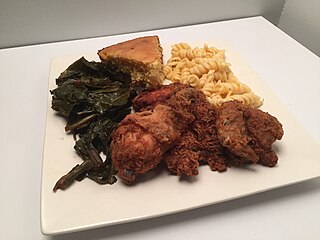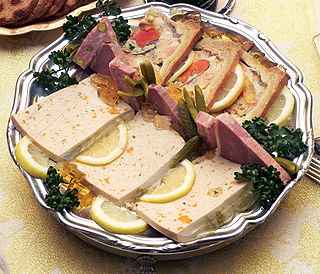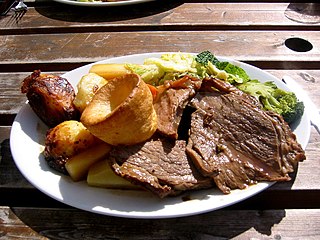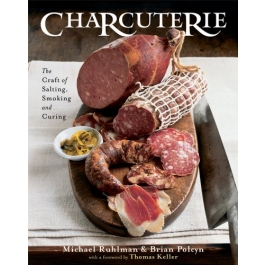Amanda Hesser is an American food writer, editor, cookbook author and entrepreneur. Most notably, she was the food editor of The New York Times Magazine, the editor of T Living, a quarterly publication of The New York Times, author of The Essential New York Times Cookbook which was a New York Times bestseller, and co-founder and CEO of Food52.

Soul food is the ethnic cuisine of African Americans. Originating in the American South from the cuisines of enslaved Africans transported from Africa through the Atlantic slave trade, soul food is closely associated with the cuisine of the Southern United States. The expression "soul food" originated in the mid-1960s when "soul" was a common word used to describe African-American culture. Soul food uses cooking techniques and ingredients from West African, Central African, Western European, and Indigenous cuisine of the Americas.

Offal, also called variety meats, pluck or organ meats, is the internal organs of a butchered animal. The word does not refer to a particular list of edible organs, and these lists of organs vary with culture and region, but usually exclude skeletal muscle. Offal may also refer to the by-products of milled grains, such as corn or wheat.

White pudding, oatmeal pudding or mealy pudding is a meat dish popular in the British Isles.

Jacques Pépin is a French chef, author, culinary educator, television personality, and artist. After having been the personal chef of French President Charles de Gaulle, he moved to the US in 1959 and after working in New York's top French restaurants, refused the same job with President John F. Kennedy in the White House and instead took a culinary development job with Howard Johnson's. During his career, he has served in numerous prestigious restaurants, first, in Paris, and then in America. He has appeared on American television and has written for The New York Times, Food & Wine and other publications. He has authored more than 30 cookbooks, some of which have become best sellers. Pépin was a longtime friend of the American chef Julia Child, and their 1999 PBS series Julia and Jacques Cooking at Home won a Daytime Emmy Award. He also holds a BA and a MA from Columbia University in French literature.

Fergus Henderson is an English chef who founded the restaurant St John on St John Street in London. He is often noted for his use of offal and other neglected cuts of meat as a consequence of his philosophy of nose to tail eating. Following in the footsteps of his parents, Brian and Elizabeth Henderson, he trained as an architect at the Architectural Association in London. Most of his dishes are derived from traditional British cuisine and the wines are all French.

St. John is an English restaurant on St John Street in Smithfield, London. It was opened in October 1994 by Trevor Gulliver, Fergus Henderson, and Jon Spiteri on the premises of a former bacon smoke-house. Under Henderson's guidance as head chef, St. John has specialised in "nose to tail eating", with a devotion to offal and other cuts of meat rarely seen in restaurants, often reclaiming traditional British recipes. Typical dishes include pigs' ears, ducks' hearts, trotters, pigs' tails, bone marrow and, when in season, squirrel. As a result, St. John has developed a following amongst gastronomic circles: "chefs, foodies, food writers and cooks on sabbatical".

British cuisine is the specific set of cooking traditions and practices associated with the United Kingdom, including the cuisines of England, Scotland, Wales and Northern Ireland. According to food writer Colin Spencer, historically, British cuisine meant "unfussy dishes made with quality local ingredients, matched with simple sauces to accentuate flavour, rather than disguise it".

Chris Cosentino is an American celebrity chef and reality television personality known as the winner of Top Chef Masters, a competitor on The Next Iron Chef and for his appearances on Iron Chef America. He is known for his haute cuisine offal dishes, and was chef-partner at Incanto in San Francisco. Forbes Traveler called Incanto "perhaps America's most adventurous nose-to-tail restaurant … On offer are lamb's necks, pig trotters and a five-course nose-to-tail tasting menu perhaps including venison kidneys and chocolate-blood panna cotta." Incanto closed on March 24, 2014. In December 2014, he opened Cockscomb, a restaurant centered around his updated interpretations of classic San Francisco dishes.

Faggots are meatballs made from minced off-cuts and offal mixed with herbs and sometimes bread crumbs. It is a traditional dish in the United Kingdom, especially South and Mid Wales and the English Midlands.

A Bacon Explosion is a pork dish that consists of bacon wrapped around a filling of spiced sausage and crumbled bacon. The American-football-sized dish is then smoked or baked. It became known after being posted on the BBQ Addicts blog, and spread to the mainstream press with numerous stories discussing the dish. In time, the articles began to discuss the Internet "buzz" itself.

Chocolate-covered bacon is an American food that consists of cooked bacon with a coating of either milk chocolate or dark chocolate. It can be topped with sea salt, crumbled pistachios, walnuts, or almond bits. References on the internet date back at least to 2005. The popularity of the dish has spread worldwide, and the dish has featured on television shows about food. A variant has been served at state fairs, where the bacon is served with chocolate sauce for dipping, and the dish has been developed into a gourmet food bar.
Giuliano Hazan is an Italian cookbook author and educator who travels throughout the world teaching Italian cooking. He is the son of Italian cooking doyenne Marcella Hazan and wine expert Victor Hazan. His use of traditional methods and ingredients combined with modern attitudes and a straightforward recipe style have made him a popular cookbook author. His cooking schools in Italy and Florida, U.S., have been profiled in many publications. Hazan is considered to be one of the foremost authorities on Italian cooking.

Everything Tastes Better with Bacon: 70 Fabulous Recipes for Every Meal of the Day is a book about cooking with bacon written by author, food commentator and The Oregonian columnist Sara Perry. The book was published in the United States on May 1, 2002, by Chronicle Books, and in a French language edition in 2004 by Les Éditions de l'Homme in Montreal. In it, Perry describes her original concept of recipes combining sugar and bacon. Her book includes recipes for bacon-flavored dishes and desserts.

I Love Bacon! is a cookbook with over fifty recipes devoted to bacon and bacon dishes, many of them from celebrity chefs. The book was written by Jayne Rockmill and photography was provided by Ben Fink. Broken down into eight sections, the book covered how to make homemade bacon and moves onto "brunch" and "small bites" before covering soups, salads and sides, pasta, fish, meat, and desserts. I Love Bacon! was published in October 2010 by Andrews McMeel Publishing and met with favorable reviews for its unique dishes and helpful culinary tips for novices.

Charcuterie: The Craft of Salting, Smoking and Curing is a 2005 book by Michael Ruhlman and Brian Polcyn about using the process of charcuterie to cure various meats, including bacon, pastrami, and sausage. The book received extremely positive reviews from numerous food critics and newspapers, causing national attention to be brought to the method of charcuterie. Because of the high amount of interest, copies of the book sold out for a period of a few months at Amazon and Barnes & Noble.
Angie Mar is an American chef and restaurateur. She owns and operates Les Trois Chevaux in New York City.
The Essential New York Times Cookbook is a cookbook published by W. W. Norton & Company and authored by former The New York Times food editor Amanda Hesser. The book was originally published in October 2010 and contains over 1,400 recipes from the past 150 years in The New York Times, all of which were tested by Hesser and her assistant, Merrill Stubbs, prior to the book's publication. The book has recipes dating from the mid 1850s, when The New York Times first began publishing topics about food and recipes.
Food52 is a recipe and cookware website. Founded in 2009 by Amanda Hesser and Merrill Stubbs, formerly of the New York Times, its website is intended as a platform for users to publish recipes and discuss cooking. The company also produces its own books.














